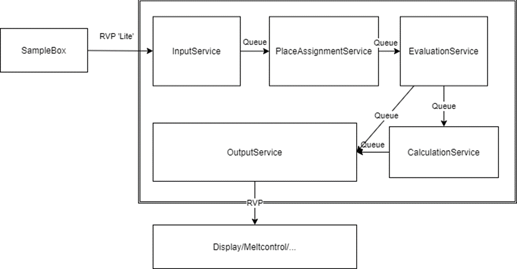Hi,
First off, I am quite new to asynchronous messaging, and to NServiceBus in particular. That said, I am investigating viability of a technical architecture for a client.
The application in question is a single-user, background service that is installed on a single appliance in an industrial environment (or on a client computer for testing, demo’s) running on Windows 10. It accepts sensory value samples on a tcp port, and sends a processed message of those samples on to a display or client application.
Inside the application are 5 ‘building blocks’ each with their own responsibility to handle the incoming values. The plan is to implement it as a single process (Windows service) to keep installation and troubleshooting straightforward.
Included is a diagram of the data flow and building blocks. Samplebox and Display/Meltcontrol are external appliances/applications. The application in question is inside the fat rectangle.
I have implemented a PoC as a Generic Host that spins up five BackgroundServices, one for each building block, and am trying to use NServiceBus to handle intra-process communication asynchrously. Since the application already requires SQL Server, I am reusing SQL as Transport. This eliminates dependency on- and installation of yet another layer such as RabbitMQ.
So far that seems to work, but I can’t solve following issues:
- Prevent data loss. Pick up where we left of in case the process or one of its blocks dies. Synchronous communication looses the sample value in that case.
- Scalability. Launch more than one instance of the block with the highest workload. Implement the competing-consumer pattern.
I think this is not a typical use case for NServiceBus, or at least I cannot find all the info I need on SO or in the docs. So I would like to ask for some help:
-
In several articles/posts I read that restarting BackgroundServices that rely on EndpointConfigurations causes issues because of the way endpoints are tied to the DI container. That would defeat the purpose of preventing data loss.
Is there a better way? -
My idea to scale out was to spin up several instances of the BackgroundService with the highest workload, and have it start the endpoint, but I saw in my PoC and read here that only the first hosted service is registered when calling AddHostedService multiple times for the same class.
Is there a better way to implement the competing-consumer pattern in this architecture? -
Your opinion on the proposed architecture? It seems to me that running each ‘block’ in its own process (Windows service) and implementing a solid Setup.exe to get them installed, would be less complex and less time-consuming than getting this to work?
-
Pricing. Since every customer would run its own instance of this application, I guess the Ultimate license is our only option?
Thx a bunch in advance.
